
29 minute read
Beautiful Towns Strolling through Brixen and Klausen
Beautiful Towns
Authors — JOSEF GELMI, MARIA GALL PRADER
Advertisement
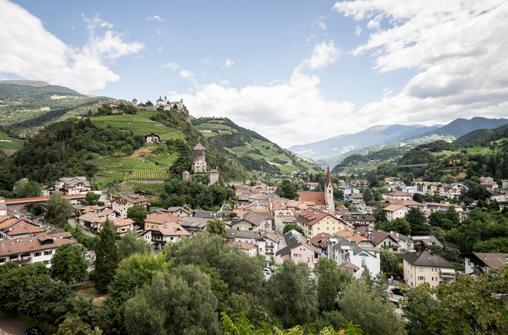
Brixen/Bressanone and Klausen/Chiusa, each with a rich cultural heritage and an eventful past as well as vibrant art scenes and exciting culinary highlights, are two towns well worth a visit. Two odes –with insider tips on art, architecture and town life
BRIXEN. T H E M A G N I F I C E N T
If I had my own ratings agency, I would give Brixen a triple A. I know the place very well, having lived here on and off since 1949. As President of Hofburg palace from 1998 to 2017, I was very much involved in town life. Now I’m delighted to be spending my retirement in this town, which I treasure so dearly and have written about so often. I love Brixen’s geographical location, healthy climate and illustrious history. But what fascinates me most is the mix of its ecclesiastical past, Austrian civilisation and Italian lifestyle. A symbolic figure for the coming together of German and Italian culture was the ingenious Prince Bishop of Brixen and Cardinal Nicholas of Cusa (in office from 1450 to 1464), who was a strong advocate for peace between religions and cultures.
Surrounded by imposing mountains, lush forests and picturesque vineyards, Brixen sits at the point where the Eisacktal valley widens into an expansive, fertile basin. It has always been a popular place to settle. The first people to lay down roots here arrived in the valley basin in around 8,000 BC. They were followed by the bishops living on the Säben mountain above Klausen, who, under Bishop Albuin, moved their seat here in around 990 after the Prihsna farmstead (which later became Brixen) was gifted to them in 901. However, the true turning point for Brixen came in 1027 when, in an effort to secure the important Brenner road, Emperor Conrad II granted the county of Eisack and Inn to Bishop Hartwig. From this moment on, Brixen continued to grow in importance. In 1048, the Bishop of Brixen (Poppo) was even elevated to Pope and enthroned as Damasus II. Emperor Frederick I awarded the bishops of Brixen the right to impose taxes, collect tolls and mint coins in 1179. From then on, they became prince bishops of the Holy Roman Empire and had a seat and voice in the Empire’s deliberative body, the Imperial Diet. Brixen was made the capital of an ecclesiastical principality, a position it retained until secularisation in 1803.
Following a period of decline during the Reformation, the town saw a frenzy of building activity in

the 18th century. During this time, Prince Bishop Kaspar Ignaz von Künigl (in office from 1702 to 1747) and Prince Bishop Leopold von Spaur (in office from 1747 to 1778) turned the medieval town into a baroque jewel, commissioning major works by famous architects and painters. I’m in total awe of what they achieved. Hofburg palace was completed in 1711, St. Joseph’s church in 1745, the new cathedral in 1754, the prince bishops’ Herrengarten palace garden in 1756 and the renovation of the parish church in 1758. Work also began on constructing the Seminary with its church and library hall in 1765. The library is particularly interesting, as together with the seminary church it is arguably the best example of rococo architecture in Brixen. Franz Anton Zeiller painted the frescoes on the six trompe l’oeil domes, which depict various theological subjects. The most noteworthy shows Jerome sitting on a lion with a ferocious face resembling that of the prince bishop at the time, Leopold von Spaur. Rumour has it that this was the artist’s way of gaining revenge for his poor pay. Be that as it may, the wondrous foresight of these two prince bishops of Brixen has, without doubt, made the town what it is today.
In the 20th century, there was a real push towards modernisation. This was driven by Mayor Otto von Guggenberg, who was the first to encourage tourism to the area. The annexation of South Tyrol to Italy in 1919, followed by fascism, the South Tyrol Option Agreement – when South Tyroleans were forced to choose between emigrating to Nazi Germany or
Brixen’s transformation from a magnificent episcopal see into a holiday destination began in the 19th century. The 1 Rappanlagen, a park located at the point where the Eisack river meets the Rienz river, was created in 1883.
1

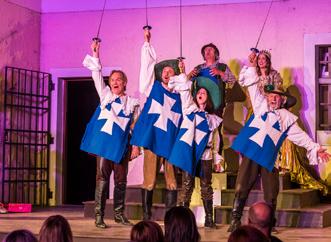
3 places for culture lovers in Brixen
A FRESH TAKE ON ART Following its refurbishment in 2019, the Stadtgalerie municipal gallery in the Große Lauben arcade is changing direction to focus on contemporary art from 2020 under the management of the South Tyrolean Artists Association. To mark the start of this new era, the space has been flooded with water and turned into a koi pond by the artist collective Butch-ennial. The gallery holds four to five exhibitions with alternating curators each year. SMALL TOWN, BIG SOUNDS The Forum Cultur series presents regular classical and contemporary concerts, operas and theatrical shows at the Forum Brixen cultural and congress centre. Audiences can also enjoy a unique atmosphere at the outstanding classical concerts performed in Brixen cathedral as part of the Musik und Kirche (Music and Church) series.
www.forum-brixen.com www.musik-kirche.it
www.kuenstlerbund.org 2 CELLAR OR PRISON? The intentionally ironically named Dekadenz, or Decadence, venue is one of South Tyrol’s four municipal theatres. Located in the Anreiterkeller, a historic coal and wine cellar, it hosts smallscale theatre, cabaret and jazz performances. In summer, Brixen’s theatre and music fans flock to the Tschumpus open-air theatre situated right next to the cathedral in the courtyard of the town’s former prison.
www.dekadenz.it www.tschumpus.com

3
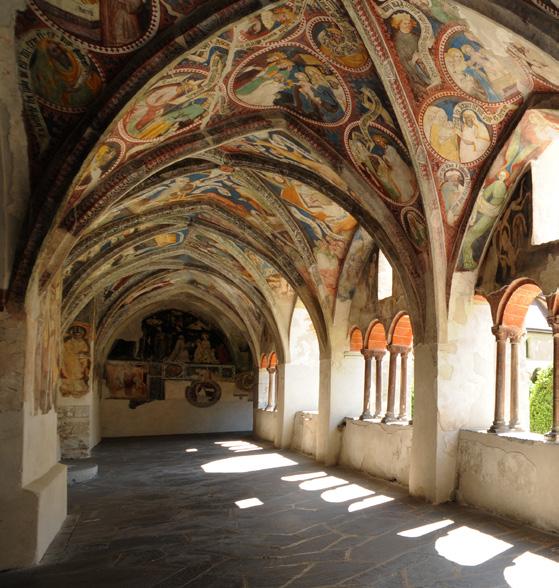
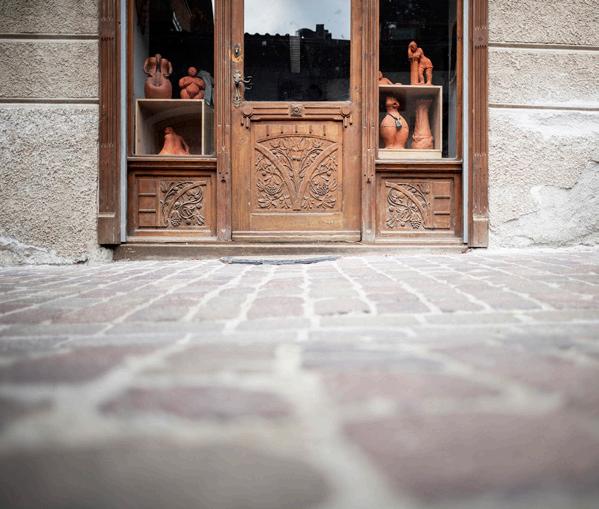
Visitors to the cathedral’s cloister should not miss the strange elephant fresco. The artist had never seen an elephant before so had to use his imagination when painting the animal and its trunk.
remaining in Fascist Italy – and National Socialism brought great upheaval. However, after the Second World War, Brixen enjoyed a period of economic and cultural recovery under Mayor Zeno Giacomuzzi between 1969 and 1988. Like me, Giacomuzzi, whom I know personally and hold in very high regard, comes from Fiemme Valley. This makes us both Brixen locals with a “migrant background”, so to speak. Giacomuzzi did outstanding work developing the town during his period in office. We have him to thank for the school, sport and industrial areas as well as the Zinggen-Rosslauf residential area.
Hardly any other town can boast so many brilliant works of art from the Romanesque period to the modern day in such a small area. The Domplatz or cathedral square, which is one of the most beautiful squares in the Alps, connects the historical cathedral quarter in the east to the unparalleled Hofburg palace complex in the west. Located on the southern side of the cathedral is the 4 Cloister, a true jewel in the town’s crown, which has been compared to the Campo Santo in Pisa but on a smaller scale. During tours, I always like to point out the elephant with the trumpet – a curious fresco painted by well-known artist Leonhard von Brixen (in around 1450), who had evidently never seen an elephant before. In fact, it was not until 1551 that an actual elephant, called Soliman, came to the town. A painting commemorating this spectacle can still be seen at Hotel Elephant today. A fantastic light show inspired by this event has also taken place in the Hofburg palace’s central courtyard in recent years.
One of Brixen’s most stunning architectural triumphs is 5 Hofburg palace, including the Diocesan Museum, which houses one of the best collections of art between Verona and Munich. One of the museum’s many highlights is a panel painting of the Man of Sorrows dating from 1450 and attributed to Jos Amann von Ravensburg. In 2015, the prominent Milan-based professor and lawyer Alberto Crespi, a

4 Hofburg palace in the heart of Brixen is home to the Diocesan Museum, one of the most beautiful collections of religious art between Munich and Verona.

5
true music and art lover, friend of Brixen and admirer of German culture, contacted me to ask whether the Hofburg would be interested in accepting the painting as a gift. I was aware that the work of art was extraordinarily valuable so I first enquired whether there were any conditions attached should the palace accept the offer.
The painting shows Jesus as the Man of Sorrows flanked by Saint Ambrose, the patron saint of the diocese of Milan, and Augustine, who was baptised by Ambrose in Milan. Above this trio is some intricate tracery with a gilded background. God the Father and the Holy Spirit are depicted in the form of a dove in the middle of the piece. The halo around the dove is the coat of arms of the famous Visconti family from Milan. The painting originates from the Saint Ambrose church in Brugherio near Milan and came
3 places for foodies in Brixen
3 DECANTEI Tucked behind Brixen cathedral surrounded by high walls, the Decantei was the official seat of the cathedral’s dean during the Middle Ages. Today, this historical building, once home to bishops, has been converted into a restaurant serving fresh twists on regional cuisine accompanied by excellent beer. Featuring two cosy courtyards and simple, understated interior design by Pedevilla Architects, it is a place for food and architecture lovers alike.
BRIX 0.1 A popular place for locals to brunch and parents with small children to spend afternoons on the terrace, transforming into a beautifully lit gourmet restaurant at night, brix 0.1 is located in a futuristic building resembling a glass cube in a small park in the south of Brixen. The innovative haute cuisine created by Ivo Messner and Philipp Fallmerayer is talked of even beyond South Tyrol’s borders.
www.brix01.com The Alte Schlachthof and Decantei are now popular restaurants, but their walls still show evidence of their respective pasts as a slaughterhouse or seat of the cathedral’s dean.
6
6 ALTER SCHLACHTHOF The white tiled walls and iron beams on the ceiling are a reminder of how this building was once used as a slaughterhouse. It has since reinvented itself as Brixen’s living room and is particularly popular with the town’s young residents. It is still known for meat – its popular burgers feature locally sourced pulled pork or venison – as well as vegetarian dishes and live music by local bands.
www.schlachthof.it
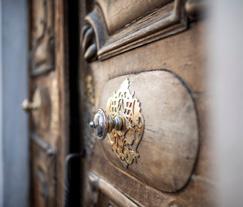
into the possession of Milan antique dealer Ruggero Longari before being acquired by Crespi. Due to its subject matter, the painting was intended to be displayed in the Diocesan Museum of Milan.
However, since Crespi had already donated a number of works to this museum and had not received much thanks from church leaders, he decided that he wanted to give this piece to either the Hofburg or the Augustinian Canons’ Monastery in Neustift/ Novacella to the north of Brixen. I worked extremely hard to make all the necessary arrangements to secure the painting for the Hofburg. Many letters and phone calls later, it was finally ours. On 9 June 2016, I travelled to Milan with the director of the Diocesan Museum, Johann Kronbichler. After completing all the legal formalities and packaging it securely, we loaded the painting into a delivery van hired especially for the occasion. But at that very moment, the heavens opened and it began to rain heavily across Milan. I thought to myself that the city must be crying for its bitter loss. It carried on raining – right until we approached Brixen, when it finally stopped and the skies cleared. Now heaven was smiling with us. That very day, the Gothic masterpiece was given pride of place in the Hofburg. The local press and prominent Italian newspapers like La Repubblica and L’Osservatore Romano covered the event. In October, I visited Professor Crespi in Milan again to thank him once more for his generous gift, this time accompanied by Mayor Peter Brunner and a delegation from Brixen.
I always end my tours of Brixen at one of my favourite spots – in front of the Tourism Association’s new building. From here, you can enjoy a spectacular panoramic view of the town and clearly see how it has changed over the centuries. The particularly successful redevelopment of the Kleiner Graben street and part of the Regensburger Allee street has made this area an even more fascinating place to visit. Look to the north and on the right you can see the Kreuztor gate, which dates from the Middle Ages and has been altered many times over the years. The parallel gate sitting alongside it was added at the start of the 20th century. This is followed by a section of the historical town wall from the 13th century. Behind this is the 7 Herrengarten palace garden, which Coadjutor and later Prince Bishop Johann Thomas von Spaur had laid out in the Renaissance style in 1570. The gardens were reopened to the pub
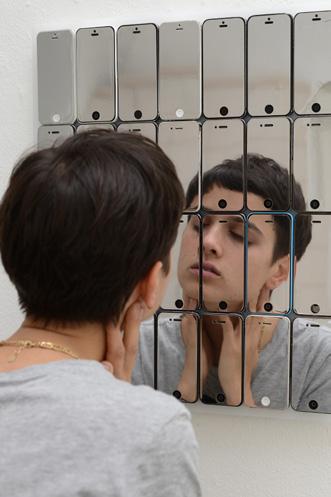
Born in 1992, AliPaloma works as a freelance artist in Innsbruck and Brixen. She creates a diverse range of works and her most recently exhibited pieces include “Unter die Haut” (“Under Your Skin”, Hofburg, Brixen), “Allein im Schwarm” (“Alone in the Swarm”, Space Nouvelle, Innsbruck) and “Born to Kill” (50x50x50 ART Südtirol, Franzensfeste fortress). From 8 November 2019, her works are on display as part of the “economy goes culture” joint exhibition in Brixen’s municipal gallery.
www.alipaloma.com
My top 5 places in Brixen Artist AliPaloma tells us about her home town
The medieval district of 8 Stufels/Stufles, my all-time favourite place in Brixen. I create my designs here in Atelier 18, an office I share with my co-workers, the director Lorenz Klapfer and the actress Petra Rohregger. Stufels is the creative heart of Brixen and there are other studios just round the corner from ours, including that of artist Hartwig Thaler.
The Anreiterkeller cellar, the home of 9 Dekadenz theatre and its cultural programme. Last summer, I designed the set for Dekadenz’s in-house production “Discussion about the Pumpkins” by Jakob Nolte. The new access to the Eisack river on the footpath from Brixen towards Neustift/Novacella. It’s the perfect place for soaking up some late summer sunshine, dipping your feet in the ice-cold water and topping up on some vitamin D before winter sets in.
The farmers’ market on Hartmannplatz square on a Saturday morning. Here you can buy an array of vegetables, cheese, eggs and other farm produce from the Eisacktal valley and stock up on local delicacies for the weekend. Don’t miss the trout stall – and, of course, the fresh Tirtln fried pastries, stuffed with spinach or cabbage.
Whenever I’m lacking inspiration, I take a stroll through Brixen’s cloister. It’s such a blissfully peaceful place that all you can hear are the tweets of the birds nesting in the Gothic arches.
Brixen’s oldest quarter, Stufels, hosts a number of artists’ studios, including AliPaloma’s (in the background of the photo).
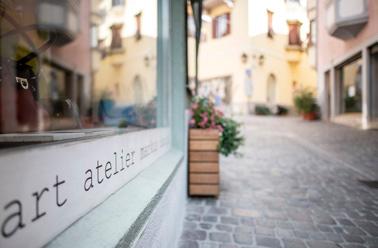
lic in 1992 after being restored based on plans from 1831. If you look up, you can see the cathedral’s ba- roque towers. In front of the old town wall is a small- er wall built in the art nouveau style. A particularly eye-catching feature is the classical lion fountain, which is also a source of fresh water. During the Wa- ter Light Festival in May 2019, an artistic production gave visitors the chance to find out how to make the lion roar. Behind the wall, you can see the west wing of the Hofburg, which was commissioned by Prince Bishop Kaspar Ignaz von Künigl in 1711, and the Hofburg chapel’s charming turret. Cast your gaze further and your eyes fall on Kassianstraße street and the old wall of the Hofburg garden, which was first refer- enced in 1265. Finally, in the distance, on the eastern slope of Brixen’s valley basin, you can glimpse the village of Milland/Millan with its parish church of Maria am Sand, which was built in 1464.
Designed by Brixen architect Matteo Scagnol, the Brixen Tourism Association’s new office was con- structed in 2018 on the former site of a war memorial and later of the Tourism Association’s old pavilion, which was designed by another famous Brixen ar- chitect, Othmar Barth. The new building’s dynamic and futuristic lines still amaze me every time I see it. Scagnol’s objective was to create a meeting place where people could enjoy a captivating view of the Hofburg. A key element of the design is the huge tree, which “looks both back to the past and towards the future” and seems to frame the building. Situ- ated diagonally opposite the Tourism Association’s new premises, the building housing the Free Univer- sity of Bozen-Bolzano’s Faculty of Education, con- structed in 2004, with its four-storey, glass struc- ture, is reminiscent of the Hofburg. It, too, forms an interesting contrast to the town’s historical centre.
Brixen has been an important spiritual and cultural centre for South Tyrol for the last thousand years. May the town keep moving forward, continue to grow in cultural diversity and – however much it cherishes its traditions – have the courage to let go of the old and embrace the new.

9

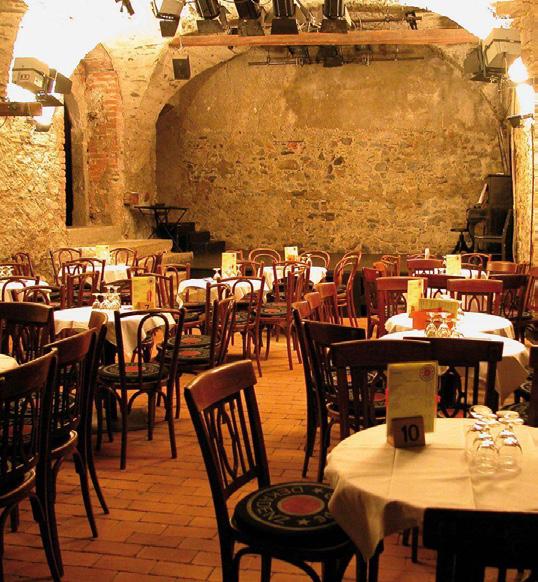
The author
8
7 Prof. Dr. Josef Gelmi was born in Cavalese in northern Italy in 1937. After studying philosophy and theology in Brixen and church history and history in Rome, he went on to work as a professor of church and diocesan history at the Philosophical-theological Academy Brixen from 1973 to 2007. He was president of Hof- burg palace and its Diocesan Museum and Diocesan Archive in Brixen from 1998 to 2017 and has written numerous publica- tions on the papal and church history of Tyrol. In 1996, he was awarded the Walther von der Vogelweide prize and in 2001 was presented with the Badge of Honour of the State of Tyrol and the Austrian Cross of Ho- nour for Science and Art, First Class. In 2009, he received the Medal of Honour from the Town of Brixen, before being named honorary canon of Brixen cat- hedral in 2016 and receiving the Medal of Merit from the Diocese of Bolzano-Brixen in 2017.

KLAUSEN. THE ARTISTS’ T O W N
Klausen’s fascinating history as an artists’ colony is rich enough to fill an entire book. If a tour guide tried to cover all aspects in detail, they wouldn’t have any time at all to show visitors the old town with its enchanting little corners and sleepy side streets. To discover more about this part of Klausen’s past, let’s first head to the former Lamplsaal hall, which today serves as a council hall and provides a fitting setting for civil wedding ceremonies and other celebrations. In 1874, kind-hearted landlord Georg Kantioler renamed the hall “Walthersaal” in a bid to attract more custom. And despite the unmissable slogan on the wall declaring “Anyone who drinks too much has not drunk well”, artists like Alexander Köster, Franz v. Defregger, Alois Gabl, Mathias Schmid and Robert Ruß certainly did spend many a jolly evening here. The names of many artists whose works can be admired in the Alte Pinakothek art museum in Munich appear in the famous guestbook of the former Gasthof zum Lamm inn. The most loyal guest was probably Ernst Lösch, an illustrator and comedian from Nuremberg who wrote two short books about Klausen’s charming yet curious inhabitants.
The Walthersaal is a true gem. The hall has been renovated twice but today it still looks like it did 150 years ago when Ernst Lösch and Charles Palmié painted it with their friends. With the exception of
10
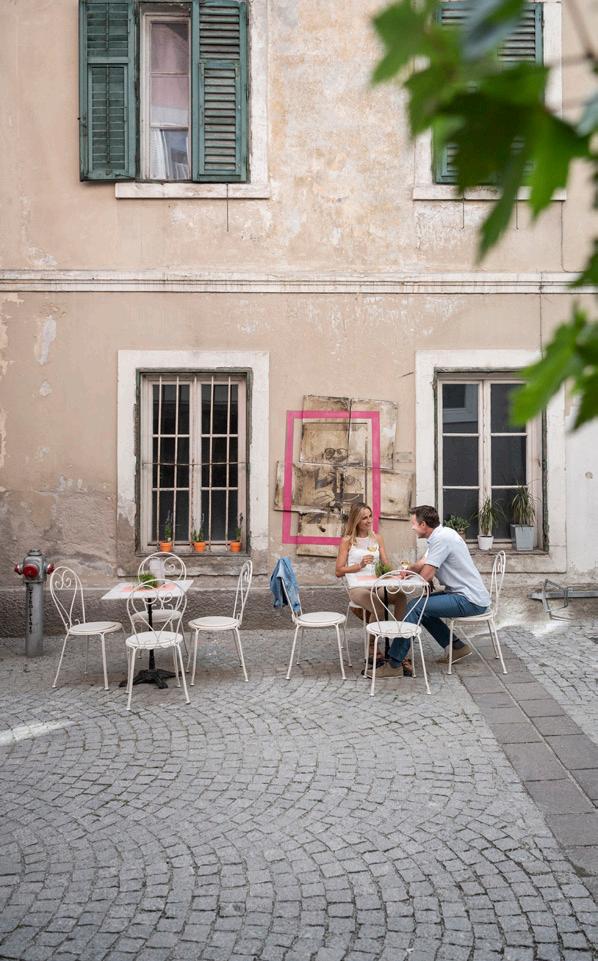
The houses in the upper town are nestled against the rocks on which Säben Abbey sits. Their gardens are accessible via the attic!
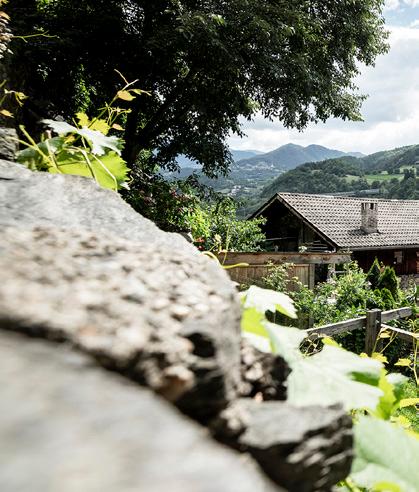
a few practical compromises to bring it in line with modern requirements, very little has changed. Even the imposing chandelier made from an iron cart wheel still hangs from the ceiling, complete with the decoratively painted cardboard stuck to it. This is a relic from a high-spirited artistic gathering one cheerful (and wine-fuelled) weekend, when Palmié and his friends turned the hall into a romantic wine lounge before the landlord could stop them. Lösch later recounted that poor Kantioler was not amused upon seeing what the painters had done to his inn. However, Lösch reported that the landlord “unwrinkled his forehead” when he noticed that the merry band of painters were taking a childish delight in their work.
The Lamplsaal was not the only artists’ tavern in Klausen at the end of the 19th and start of the 20th century. Other popular artist haunts included the Gothic wine bar in Mondschein, the Gallmetzer studio on Pfarrplatz square, the Rauterstube (the famous Klausen Batznhäusl inn in Kreuz), the zur Post inn, the Rabensteiner studio and the Köster studio in Griesbruck. While little evidence remains of these former artists’ taverns, in today’s Walthersaal there is a painting commemorating troubadour Walther von der Vogelweide. It is also thanks to him that Klausen found sudden fame in the late 19th century. When Innsbruck-based professor Ignaz Vinzenz v. Zingerle (along with several other researchers) announced that he believed he had found the troubadour’s birthplace at Innervogelweiderhof farm
in nearby Lajen-Ried/Laion-Novale, his academic articles and strong personality attracted all manner of artists from Germany and Austria to the Eisacktal valley. They arrived on the newly constructed railway and, on disembarking, discovered a small, sleepy, medieval town that felt in tune with their romantic spirit: Klausen. A place where time seemed to stand still. A place where artists, writers, sculptors and researchers would return every summer and inspire each other’s creativity. A place where, if they grew weary of the idyllic surroundings and tranquillity, all they had to do was catch the next train from the station near the Krone inn and head for the hustle and bustle of city life once more.
11 Both the art scene and tavern culture flourished in Klausen at the end of the 19th and start of the 20th century when artists like Ernst Lösch and Charles Palmié enjoyed socialising and drinking in the town’s inns.

The "Kunst boden_nah" project invites young artists to live and work in Klausen. What they leave behind is a series of artworks in public places, and perhaps a few broadened horizons as well.
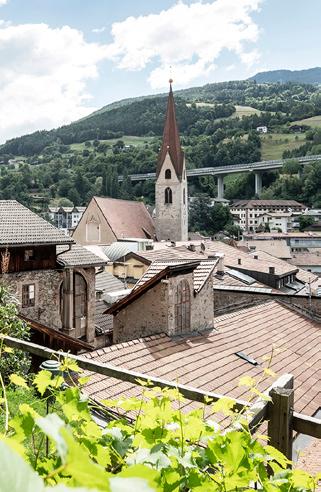
3 culinary and cultural highlights in Klausen
10 KUNST BODEN_NAH This contemporary art project describes itself as a “gallery concept that is not tied to any particular place”. International artists are invited to live and work in Klausen as resident artists, where they exhibit their works in empty business premises and public places in return for board and lodging. Three young artists are due to take part in 2020 (exhibition: 7–14 August 2020). 11 GASSLBRÄU Klausen’s old town is home to one of eight brewery taverns found in South Tyrol. Here Norbert Andergassen brews pale, dark and wheat beer in accordance with German purity requirements, as well as creative seasonal craft beer varieties, such as the popular chestnut beer. The tavern also serves excellent food.
www.gassl-braeu.it
www.kunstbodennah.it
GOLDENE ROSE In the “Golden Rose”, the town’s oldest inn, patrons can dine just like Klausen’s legendary artist community once did. Dishes from this period, such as tripe and cod hash, are prepared on an old wooden stove. The naturally ventilated, chic stone cellar is an ideal location to enjoy a cigar and some gin.
www.goldene-rose.it
After the First World War, the art colony’s star suddenly faded. In recent years, however, Klausen has been stepping up its efforts to revive its artistic past through special exhibitions at its municipal museum, the Artists in Residence initiative, partnerships with other artist towns and cities and the Kunst boden_nah art project, which creates closer links between artists and the public. Today, a surprising phenomenon is emerging: thanks to Sonya Hofer and Astrid Gamper, Klausen now has a strong female artist scene. Both artists focus on very profound subject matters. Layer by tiny layer, Astrid Gamper covers the female body and partly exposes it again – her intensive creative process of building up and removing layers revealing how women are both vulnerable and strong. Sonya Hofer is currently experimenting with clay and shells as the symbol of the origin of life.
Located in the former Capuchin monastery with its peaceful inner courtyard, Klausen’s Stadtmuseum or municipal museum holds temporary exhibitions that are inspired by the town’s past as an artists’ colony.

12
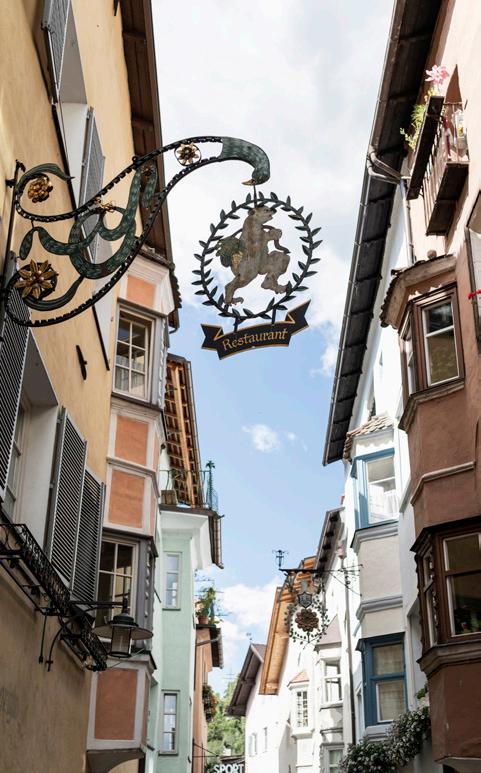
It is now time for us to leave the Lamplsaal and look up at the beautiful old inn sign as we do. Colourful 12 iron inn signs can still be found all over Klausen, even on buildings that have long since ceased to be taverns, such as the Mondschein, Grauer Bär and Weißes Rössl. On the opposite side of the street is the Walther von der Vogelweide inn with its striking crenelated roofline, which was first mentioned as a tavern and bathhouse for wealthy citizens in the Middle Ages. Once called the Löwenwirtshaus, it was renamed after being purchased by the Lamplsaal’s landlord, Kantioler. Its beautiful front façade facing the Eisack river is adorned with a fresco depicting the very same troubadour who gave it its name. The inn was famous for its Mediterranean “Walther” garden, which extended all the way to the Eisack and became a relaxing place for artists to meet. Today, the “Vogelweide”, as Klausen residents affectionately call it, is known for its spectacular terrace. Its young manager, Simon Rabensteiner, is also in the final stages of converting the rooms into a small art hotel.
Walking southwards down the long, narrow cobbled street through the upper town, we reach a green building on our left, which at just under three metres wide is the narrowest house in Klausen. Its 100 square metres of living space are spread across five storeys and it also features a stone cellar. If you walk down to the Eisack river via the nearby Tränkgasse lane, you can see the small garden belonging to the house – a gravelly, rectangular patch with an old pear tree that provides shade in summer.

Today, women have a strong influence on Klaus- en’s art scene. Pictured: Sonya Hofer’s 2018 portrait of the abbess of Säben Ab- bey, Marcellina Pustet, as well as a piece from Astrid Gamper’s 2018 series “Hül- len” (“Layers”), in which she attempts to portray women as both vulnerable and strong.
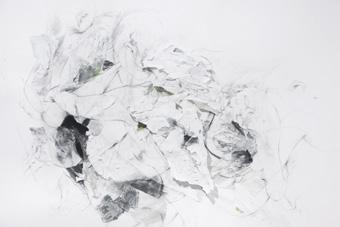
13
All the houses in the upper town have gardens. In the houses facing the Eisack the garden is accessible via the cellar, while in those facing Säben mountain, it is accessible via the attic! The houses in Klausen’s old town are built on an incline. They seem to be pressing themselves against the rocky Säben moun- tainside as if they are trying to protect themselves from the Eisack river, which puts them at regular risk of flooding. The town’s Italian citizens have coined the expression “the secret gardens of Klausen” to describe the gardens facing Säben mountain be- cause although hardly visible, they offer magnificent views.
Let’s return now to the narrow street through the old town, which throughout history 66 German kings and emperors as well as countless merchants and pilgrims have travelled along on their journey south. Balconies were prohibited along this bottleneck, along which everyone who ventured over the Bren- ner pass by carriage had to trundle. To make up for this, each house has bay windows to let in light and to allow occupants to look out at (or, in some cases, monitor) the entire street. The houses in the upper and lower town are painted in a beautiful array of colours, creating a gentle sea of pastel tones, which are stipulated by a municipal colour committee. Any
14

Two Artists Astrid Gamper and Sonya Hofer on their town
“We love the tranquillity, nature and culture in Klausen. Thanks to modern means of communication, we as artists feel connected to the entire world even from a town as small as this.”
13 Born in 1971, Astrid Gamper studied graphic and fash- ion design and has been working in her studio in Klaus- en since 2000. Most recent exhibition: “Unter die Haut” (“Under Your Skin”, Stadtmuseum Klausen).
“One of our favourite cultural highlights in Klausen is the Stadtmuseum. This municipal museum organises five special exhibitions a year, showcasing a wide range of contemporary art.”
14 Born in 1948, Sonya Hofer lives and works in Klaus- en as a freelance artist, portrait painter and art educator. Most recent exhibition: “Schalen” (“Shells”, 50x50x50 ART Südtirol, Franzensfeste fortress).
The pair launched the “ars sacra – Kunst und Kirche im Heute” (“ars sacra – Art and the Church Today”) project in Klausen in 2018.
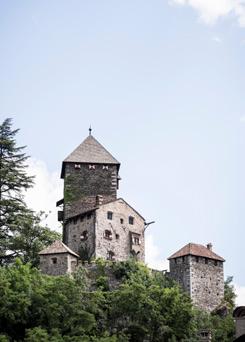
home owners wishing to carry out alterations are subject to very strict conditions. Almost all the houses in the old town have nevertheless been lovingly refurbished and together create a beautiful picture. They are so close together that in 1867 a German travel reporter wrote that a tall barber with “particularly long arms” could easily shave the beard of the person living opposite by reaching through the windows. Today, this close proximity is used to bring the place to life by hanging colourful decorations, such as umbrellas or flags, on a rope that criss-crosses the street. Back on ground level, small, enticing shops offer a warm welcome and personal service from friendly owners who love to chat to passers-by.
The black door on the magnificently whitewashed house in the middle of the upper town is particularly remarkable, as it owes its deep black colour to the stain added by the owners for protective purposes. Two coats of arms on the door indicate how this building once belonged to the bishop, before being given to the town to serve as the town hall and school house. The key tilted to the left in Klausen’s coat of arms symbolises that the town’s gates open for those who have paid their tolls, but remain closed to those who have not. With a lamb and cross in its flag, the other coat of arms represents the bishop of Brixen, to whom Klausen was directly subject until secularisation in 1803. This is also strikingly portrayed by the colourful frescoes with the bishop’s coats of arms on the toll house near the Brixner Tor gate. The buildings in the upper town are steeped in history. Examples include the town hall connected to the Church of the Apostles; the school, which was converted from three former houses in 1912; the Neustift’sche Haus, which served as the zum Schlüssel inn in around 1900; the Altlöwenhaus with its painted coats of arms and arched doors; the Frühmesnerhaus, which has recently been renovated by the Rabensteiner family; the old courthouse, which once belonged to the nobles from Villanders/Villandro; and the Brunnerhaus with its elaborate wooden front door. They all have exciting stories to tell. However, the upper town is about much more than its past. Alongside shopkeepers and restaurateurs, craftspeople still continue their traditional trades here – from Gretl Mair the goldsmith and Nora Delmonego the young shoemaker to Hermann Plieger the decorative metalworker. Taking a stroll through Klausen’s old town means following in the footsteps of the members of the artists’ colony who fell in love with the enchanting allure of its medieval buildings and its charming people at first sight.
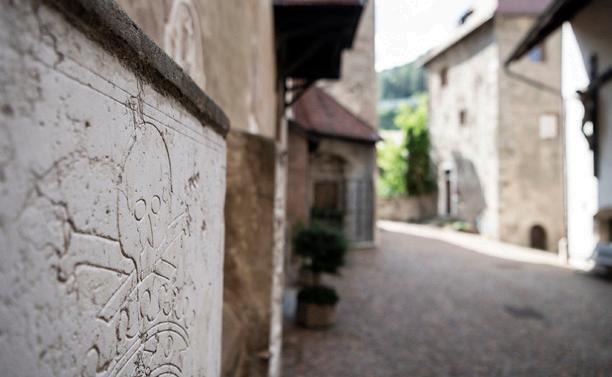

Balconies were prohibited on the narrow street through Klausen’s old town which every carriage once had to pass along on its way through the valley. To make up for this, each of the pastel-coloured houses has bay windows to let in light and give its occupants a good view of the street.
The author
Born in 1955, Maria Gall Prader studied educational sciences and German as a foreign language, before completing a research doctorate in general education, didactics and social pedagogy. She works as a lecturer, research fellow, tour guide and writer. Her most recent publication is Klausen gestern und heit – 30 bsundere Leit (“Klausen Yesterday and Today – 30 Characters”), published by Athesia.
Getting into the Christmas spirit

The BRIXEN Christmas Market on the cathedral square is one of the most festive in South Tyrol. The small wooden huts sell a variety of local crafts and culinary specialities. The light artists from Spectaculaires lend some added sparkle to the dark winter months, bringing Hofburg palace to life with their colourful light and music show running from late November to early January
With its torchlit streets, jugglers and fire-breathers entertaining the crowds in the old town and alphorns playing traditional Alpine songs, the Medieval Christmas in KLAUSEN transports visitors back in time. Even the market stall holders selling artisan products are dressed in historical clothes made of velvet and wool.
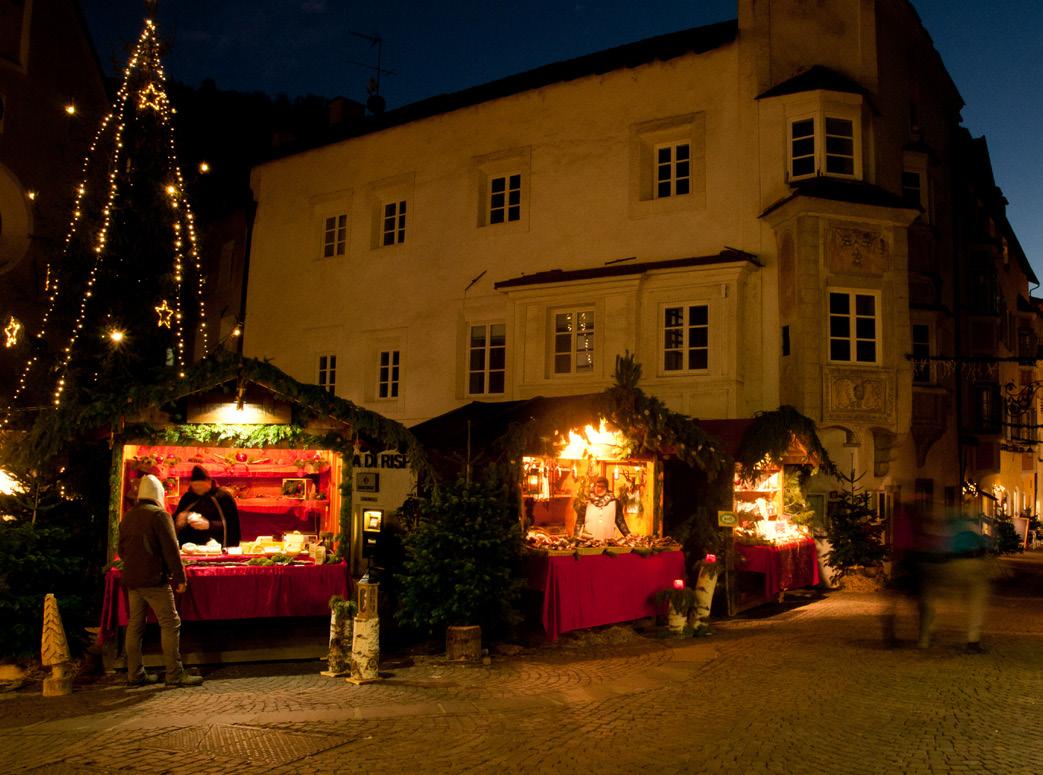
www.brixen.org www.klausen.it
A Quiet Wonderland

Together, the Rodenecker Alm and Lüsner Alm Alpine pastures form one of the largest high-altitude pastures in Europe, spanning 20 square kilo- metres. Located at 1,800 to 2,300 me- tres above sea level, in winter they boast 50 kilometres of cross-country skiing trails. They are also ideal for snowshoeing, ski touring and tobog- ganing and offer spectacular views across the Dolomites, Sarntal Alps, Zillertal Alps, Rieserferner Group and High Tauern.










